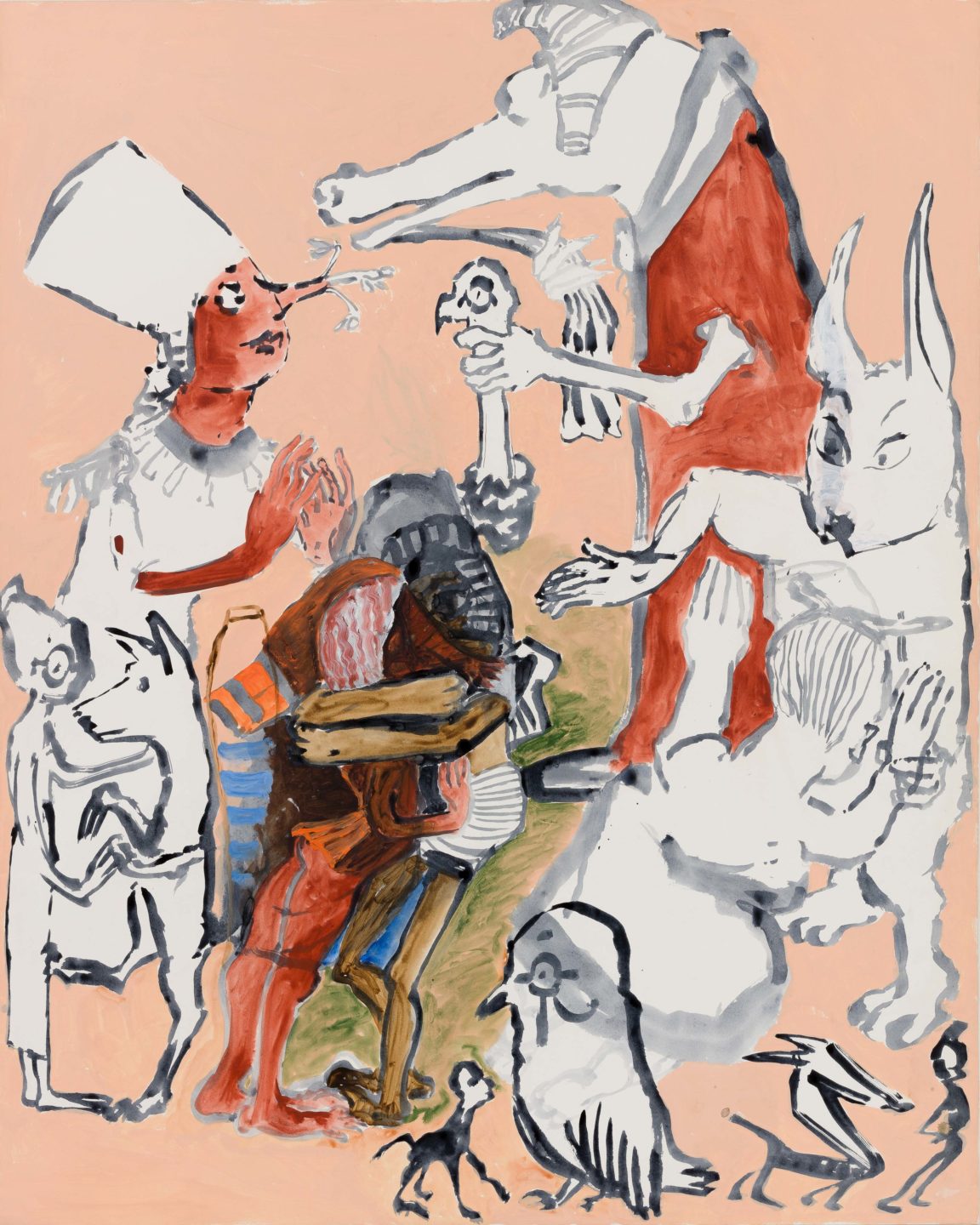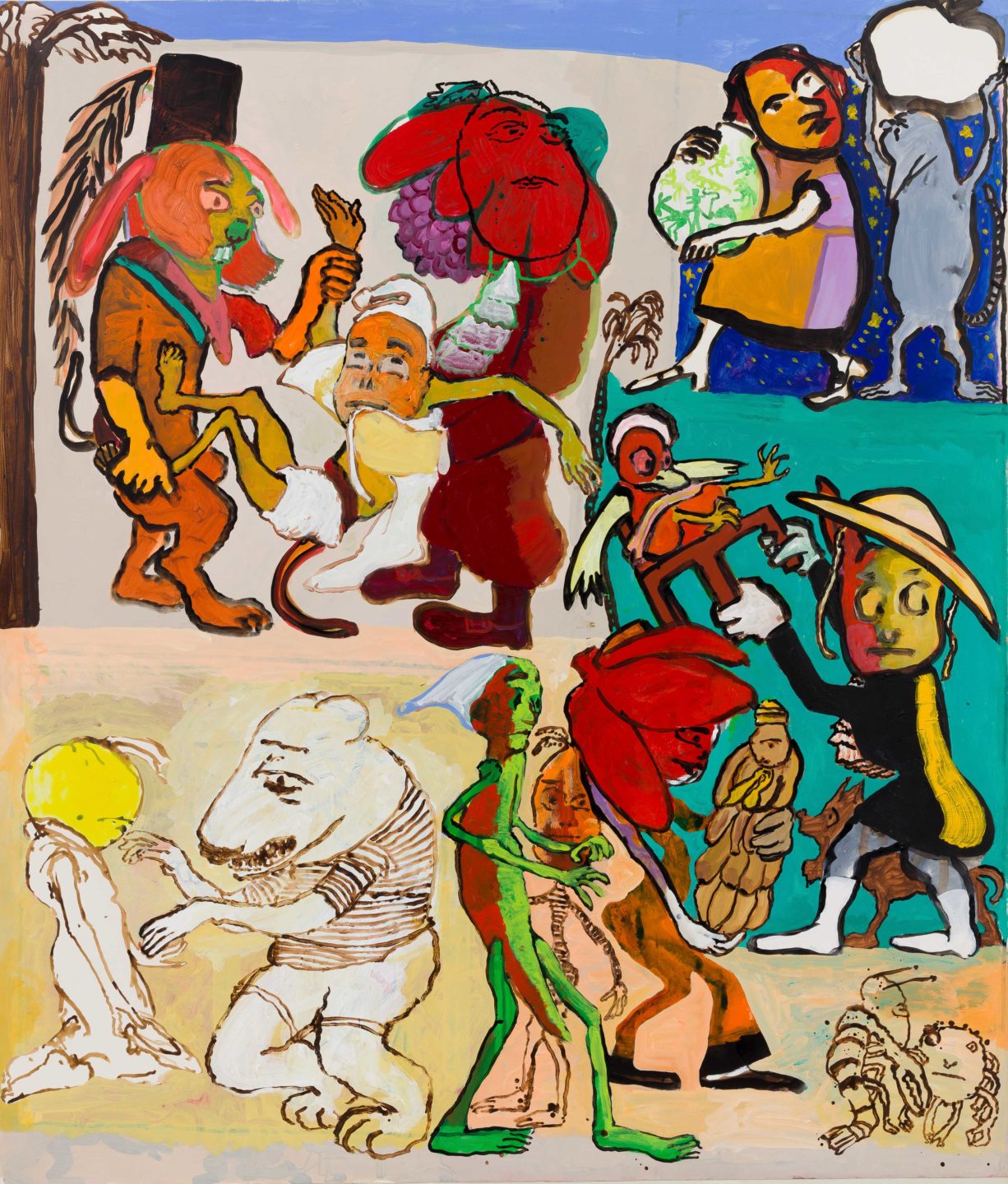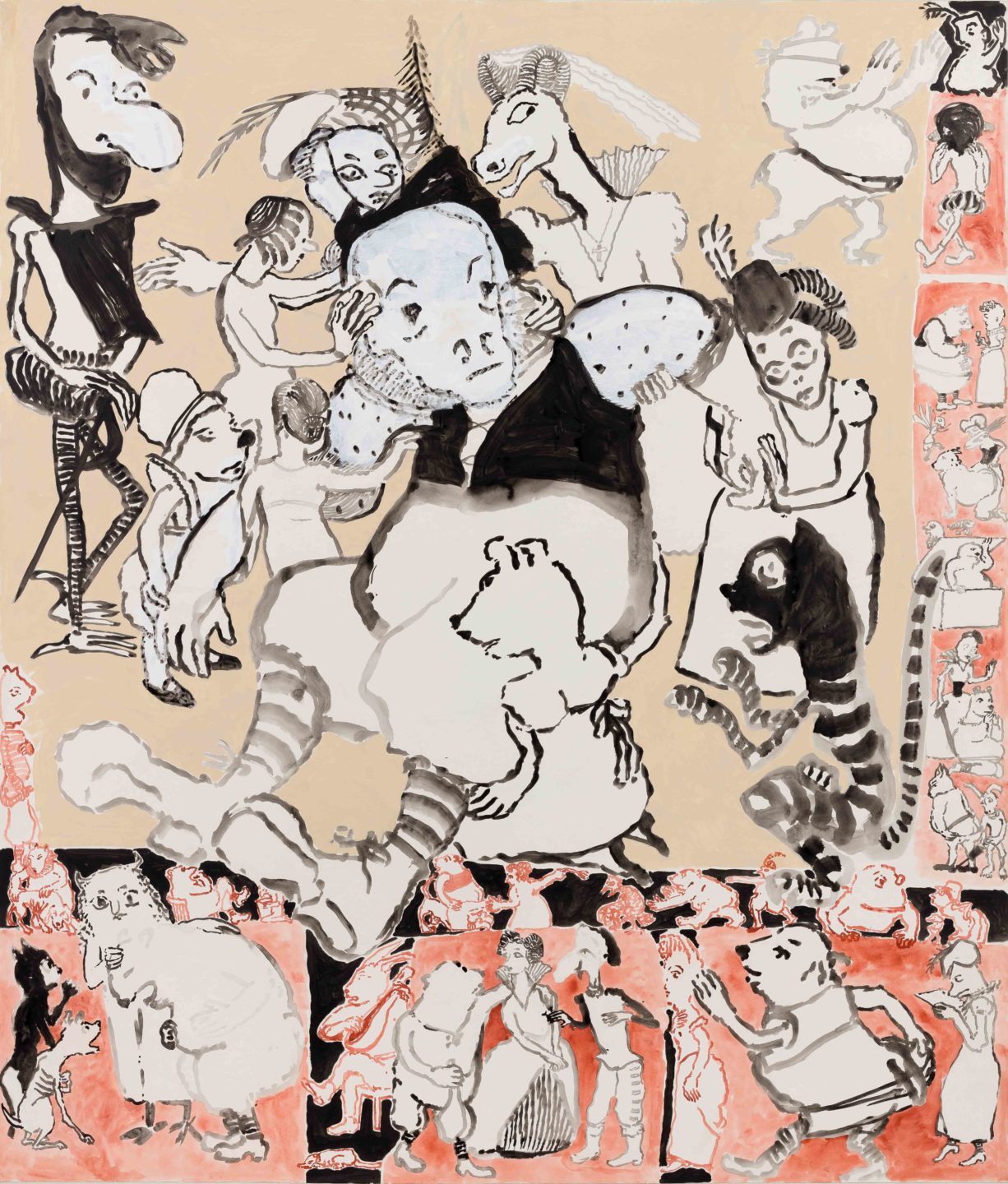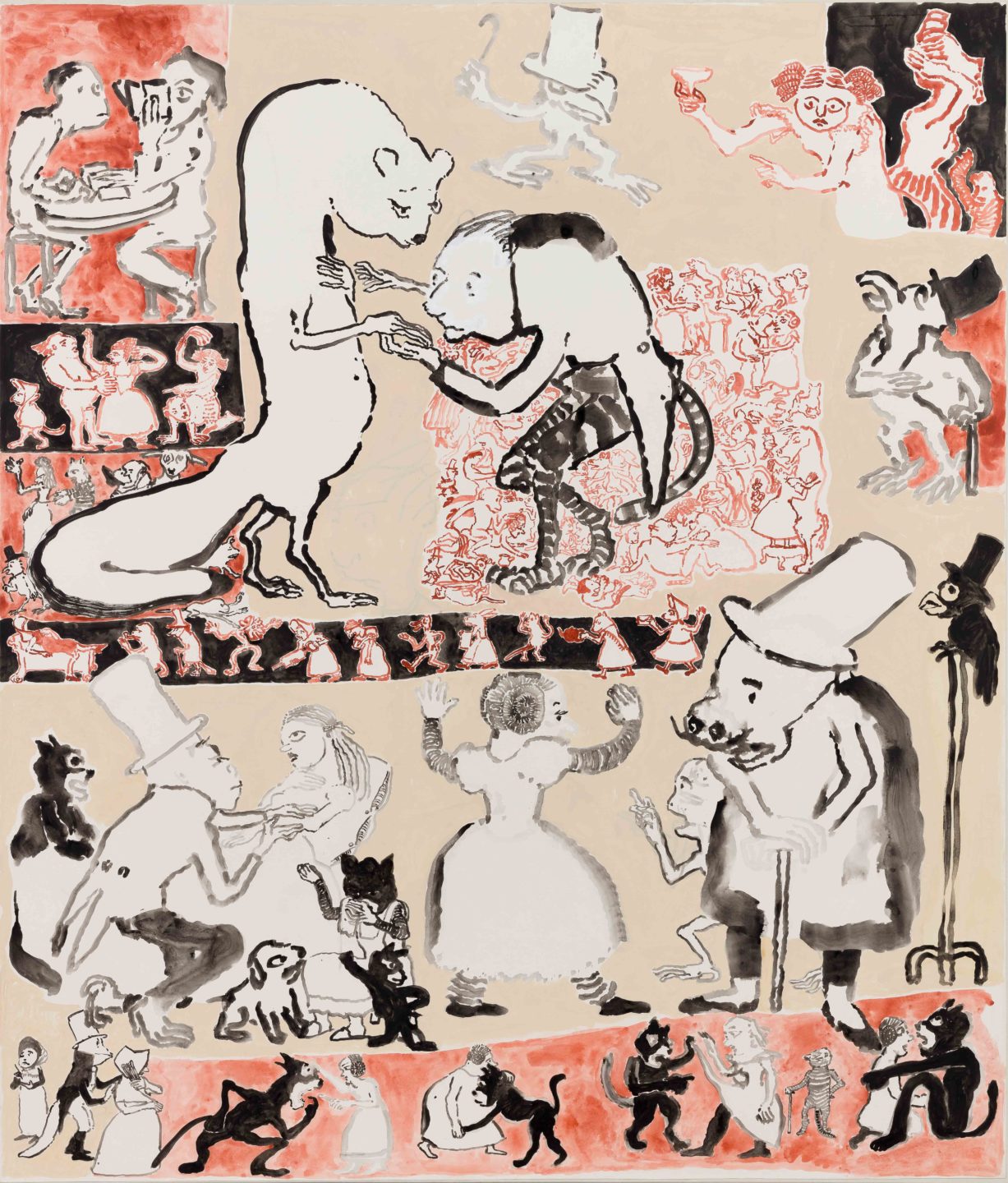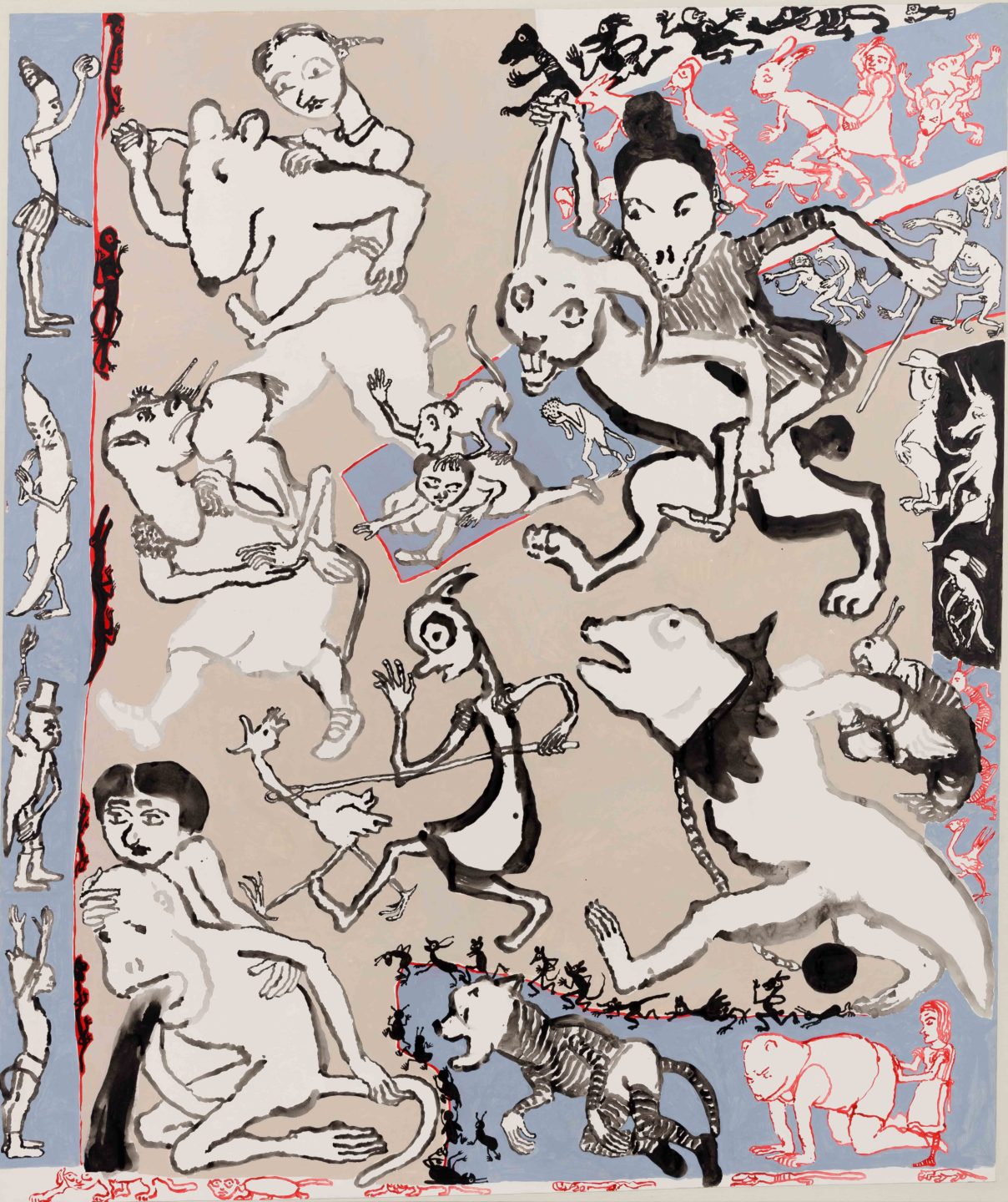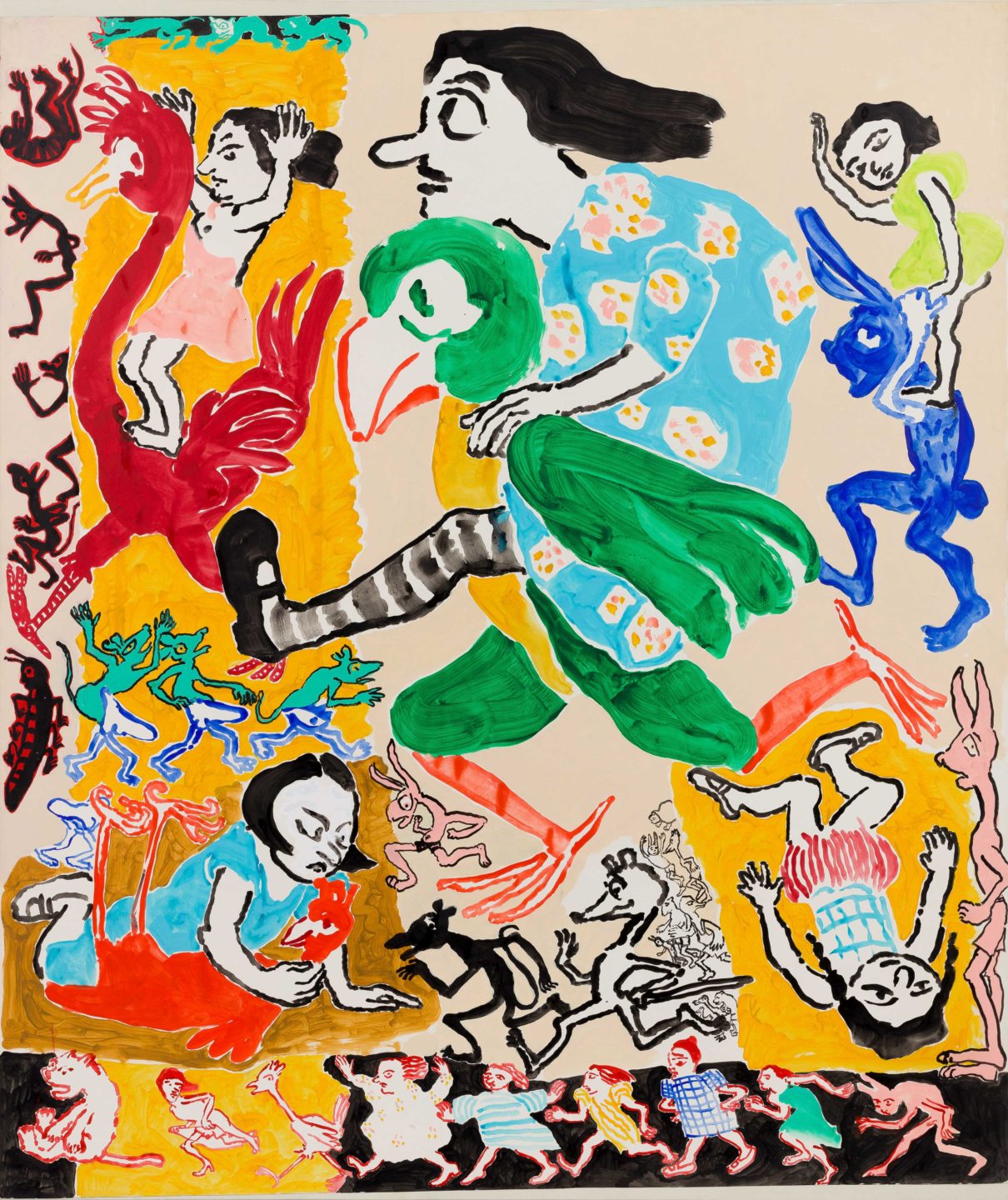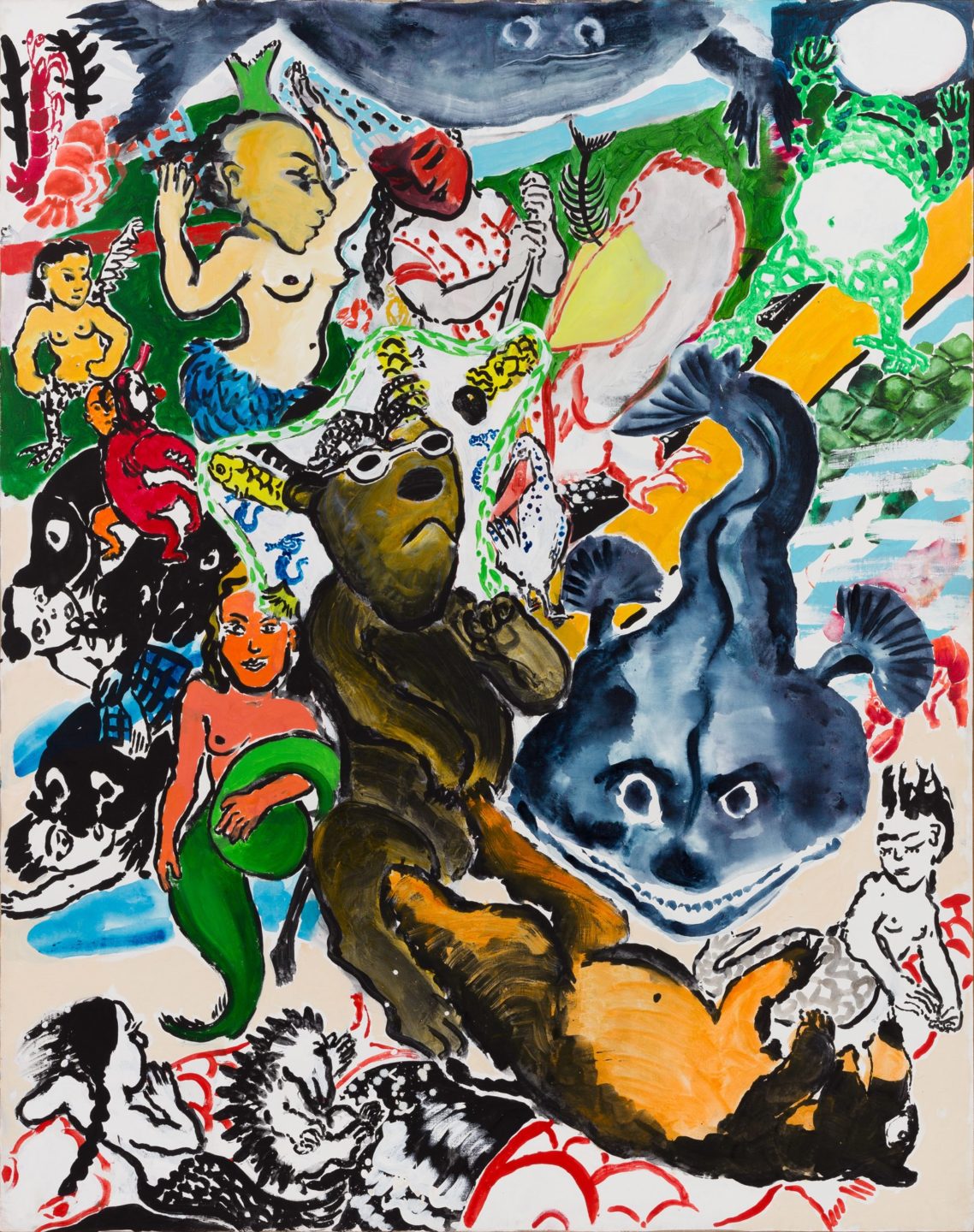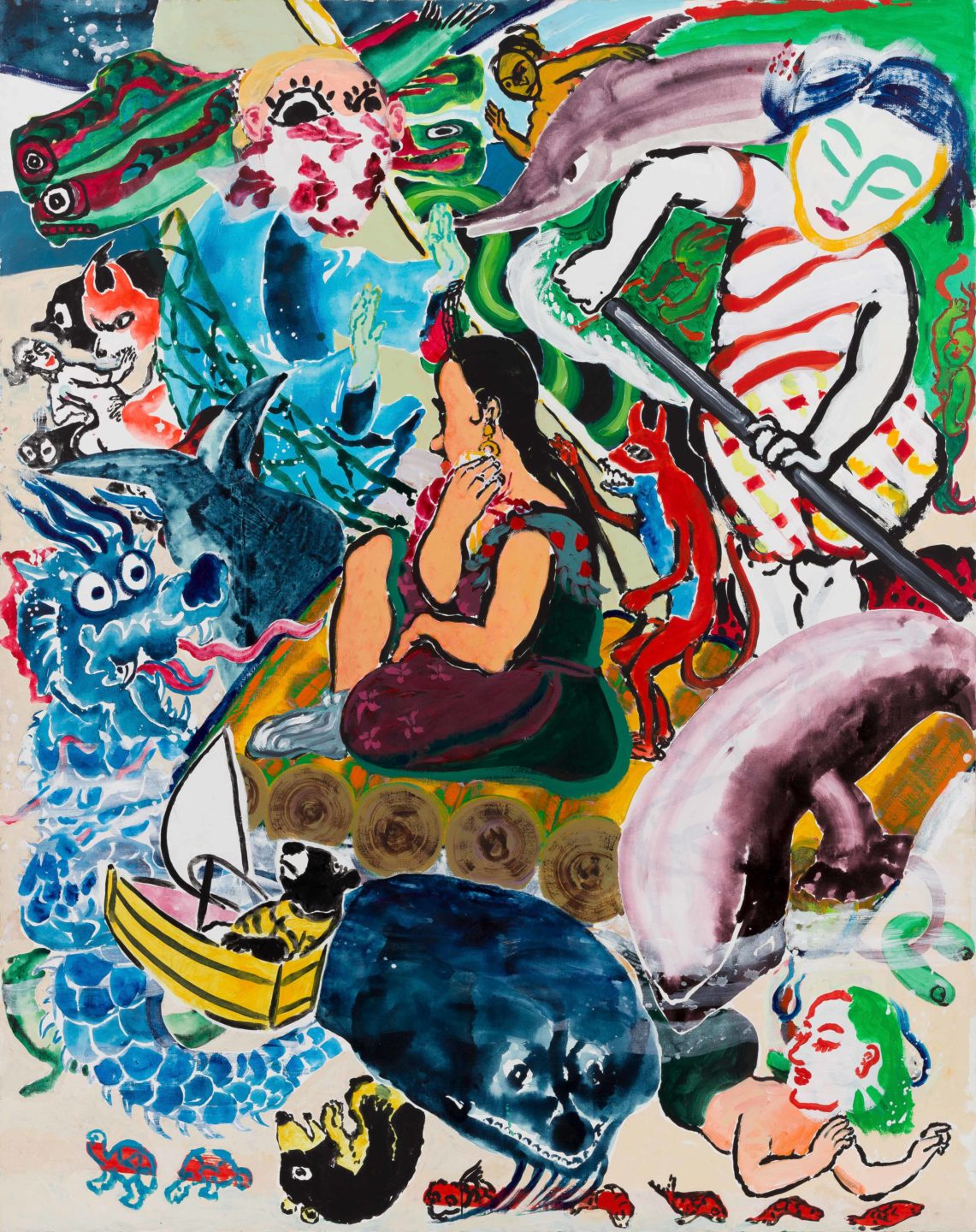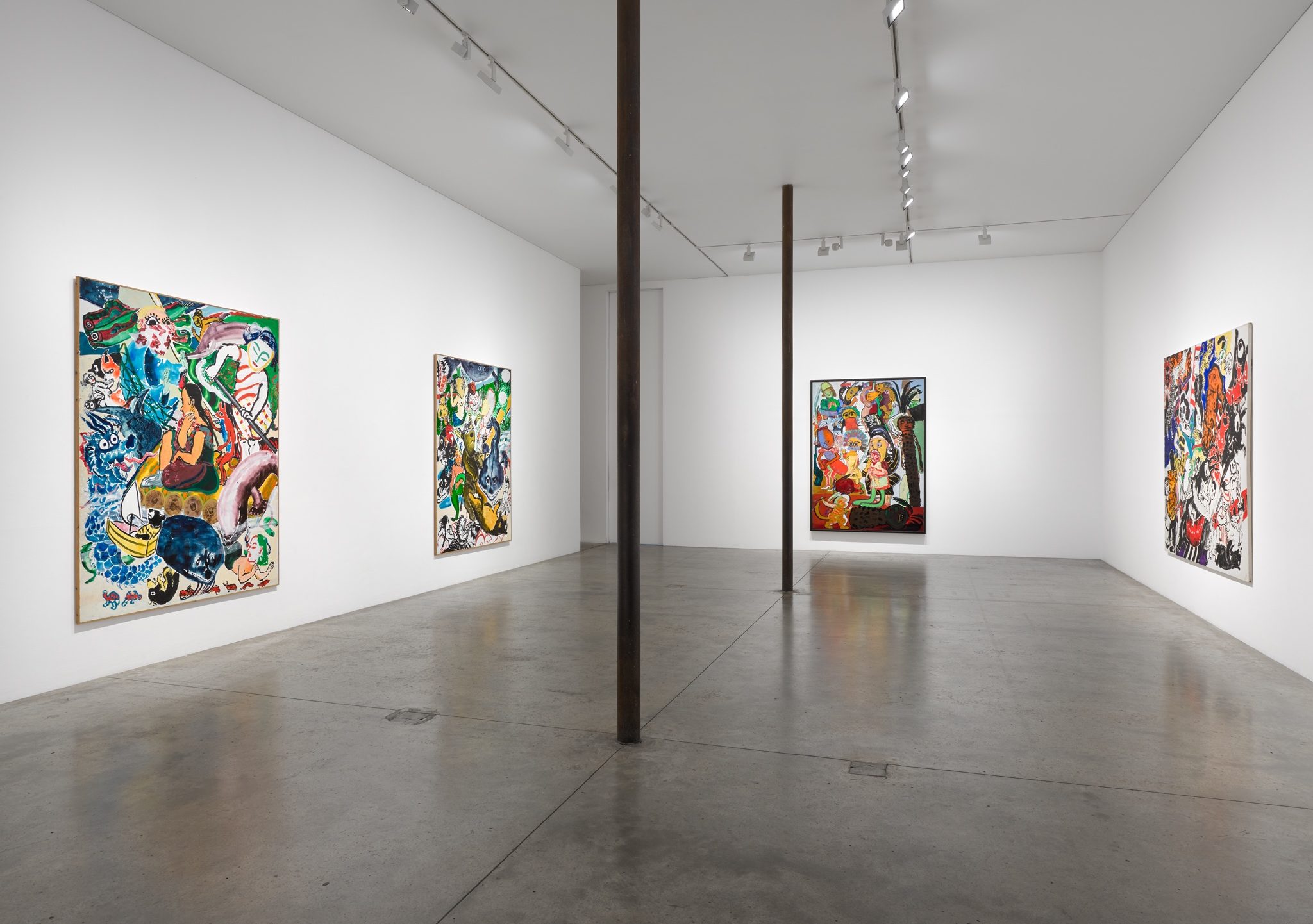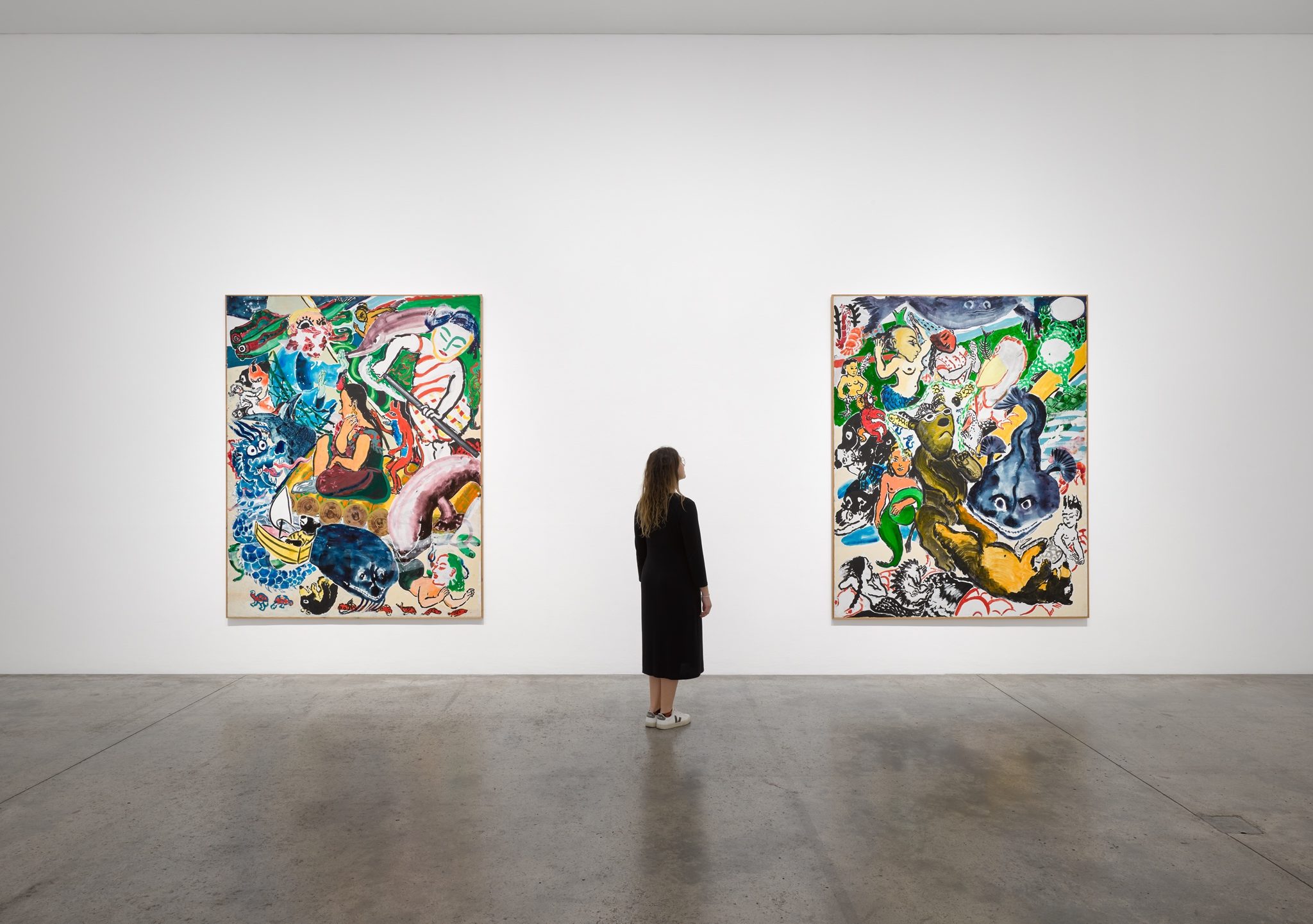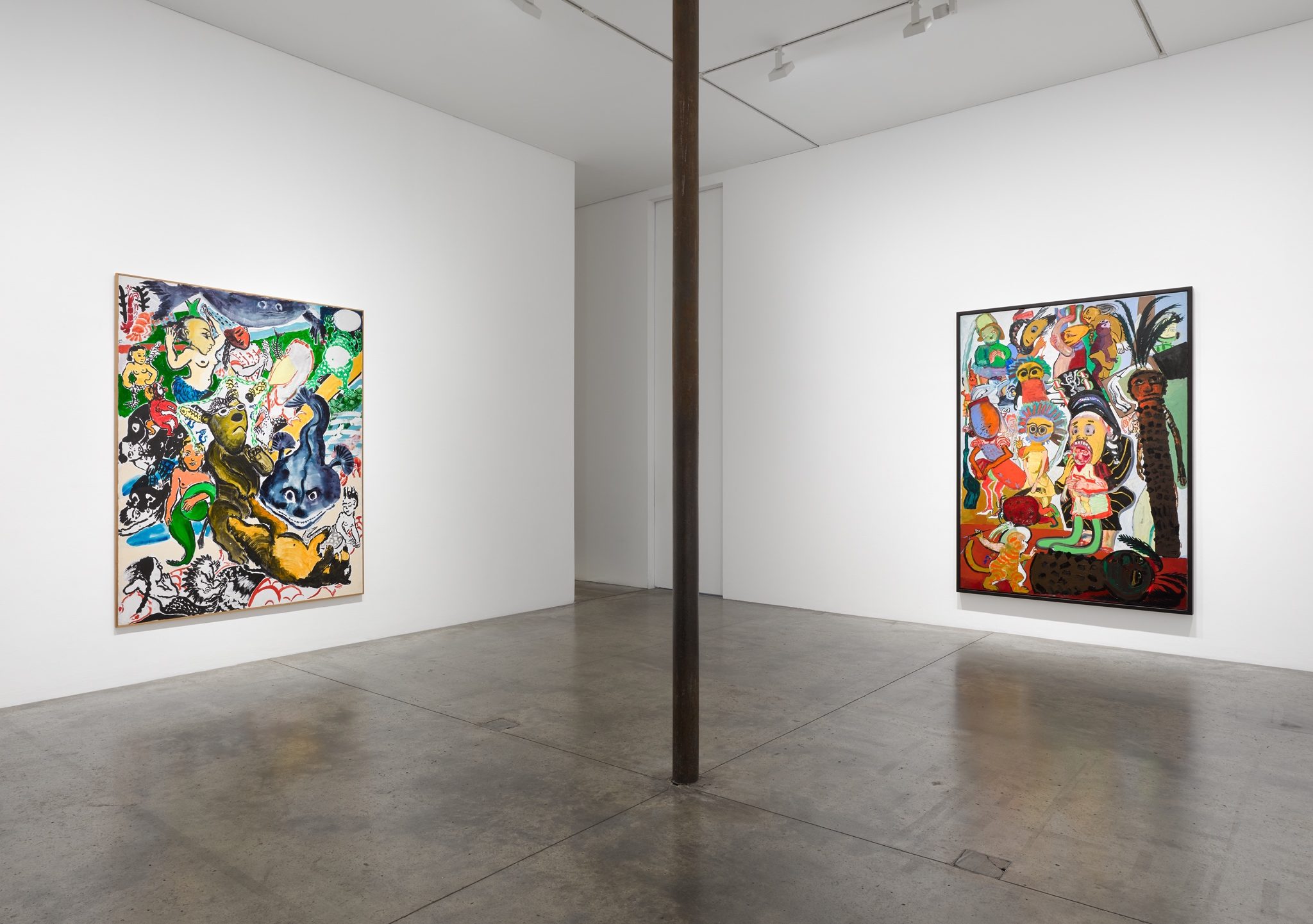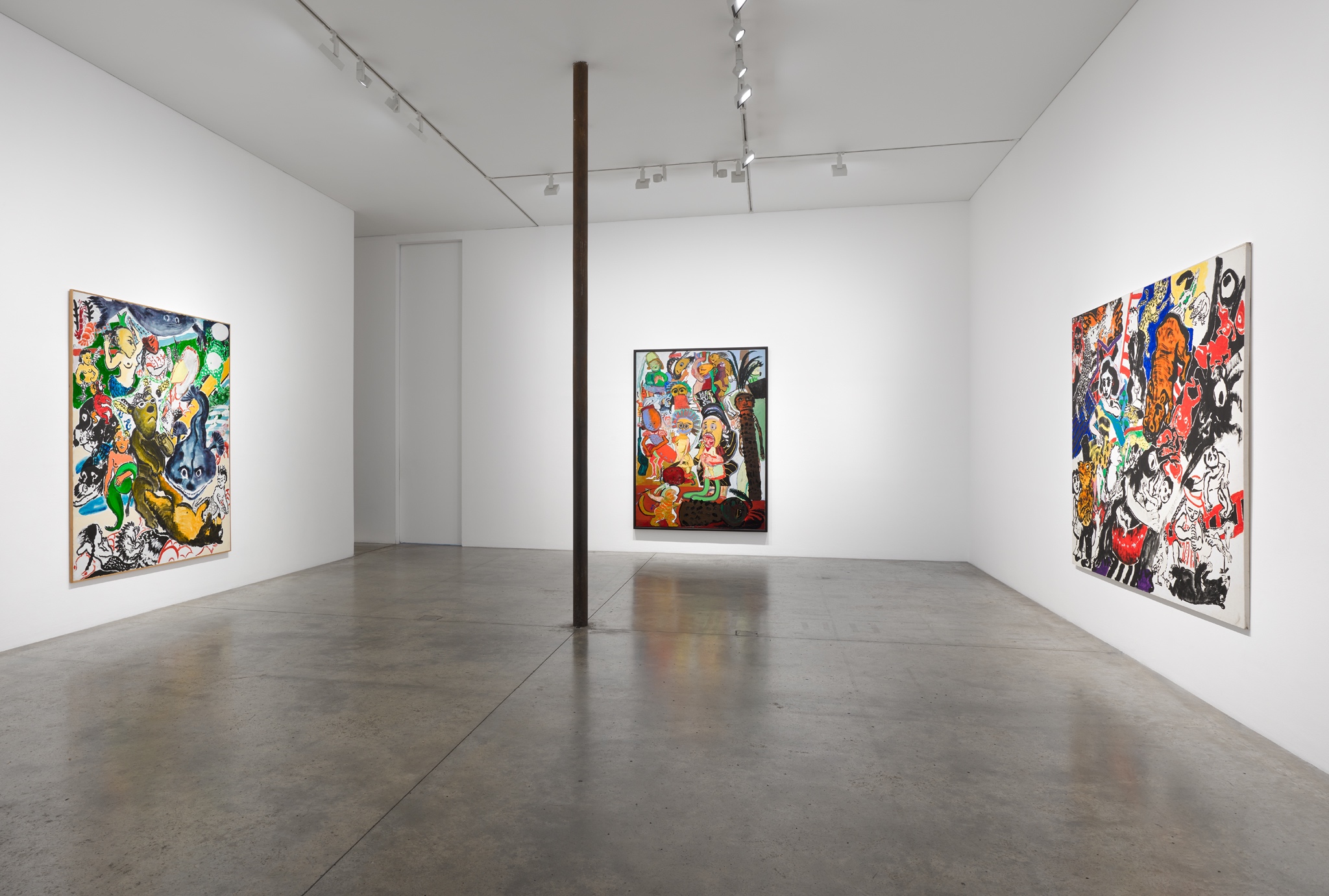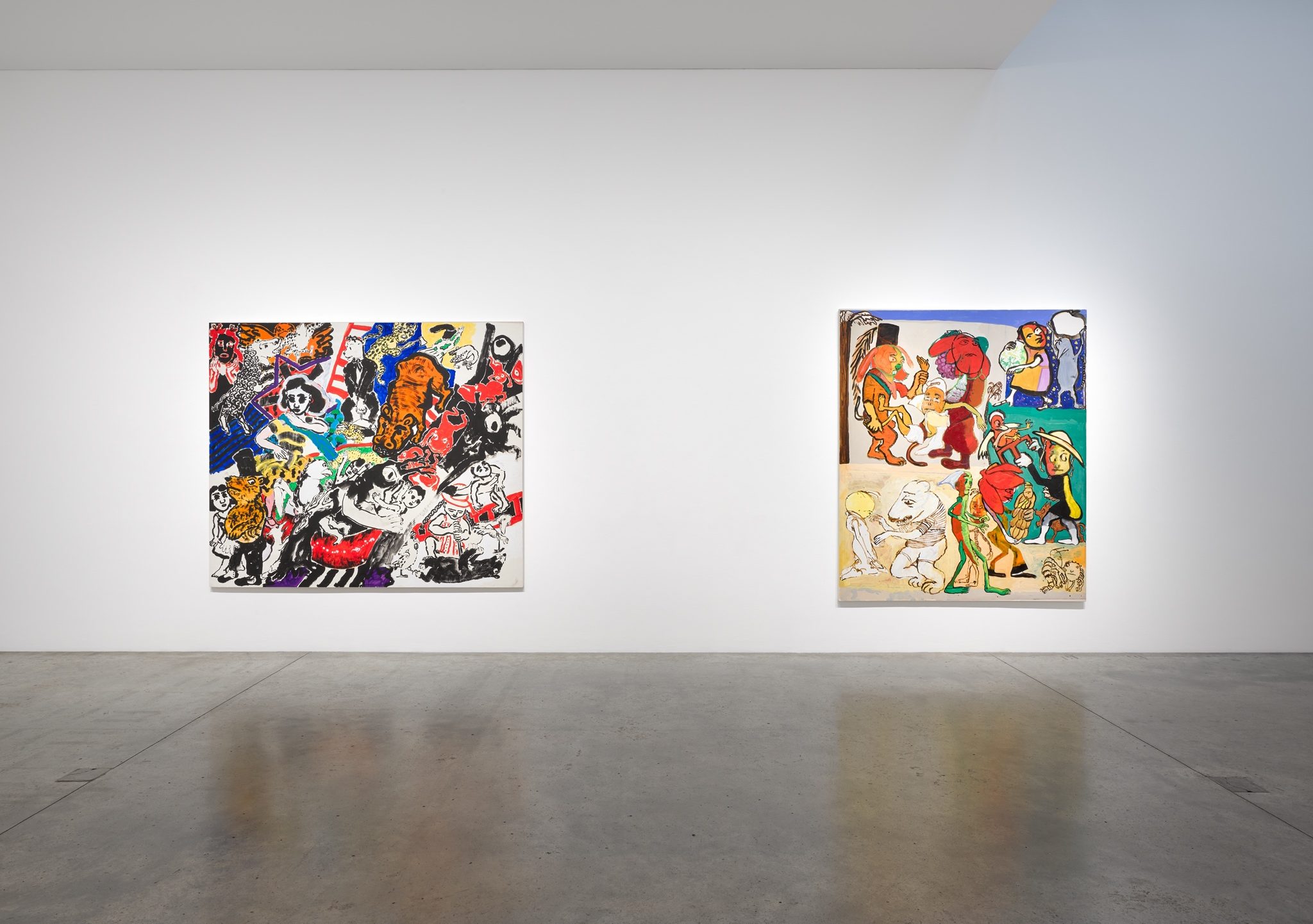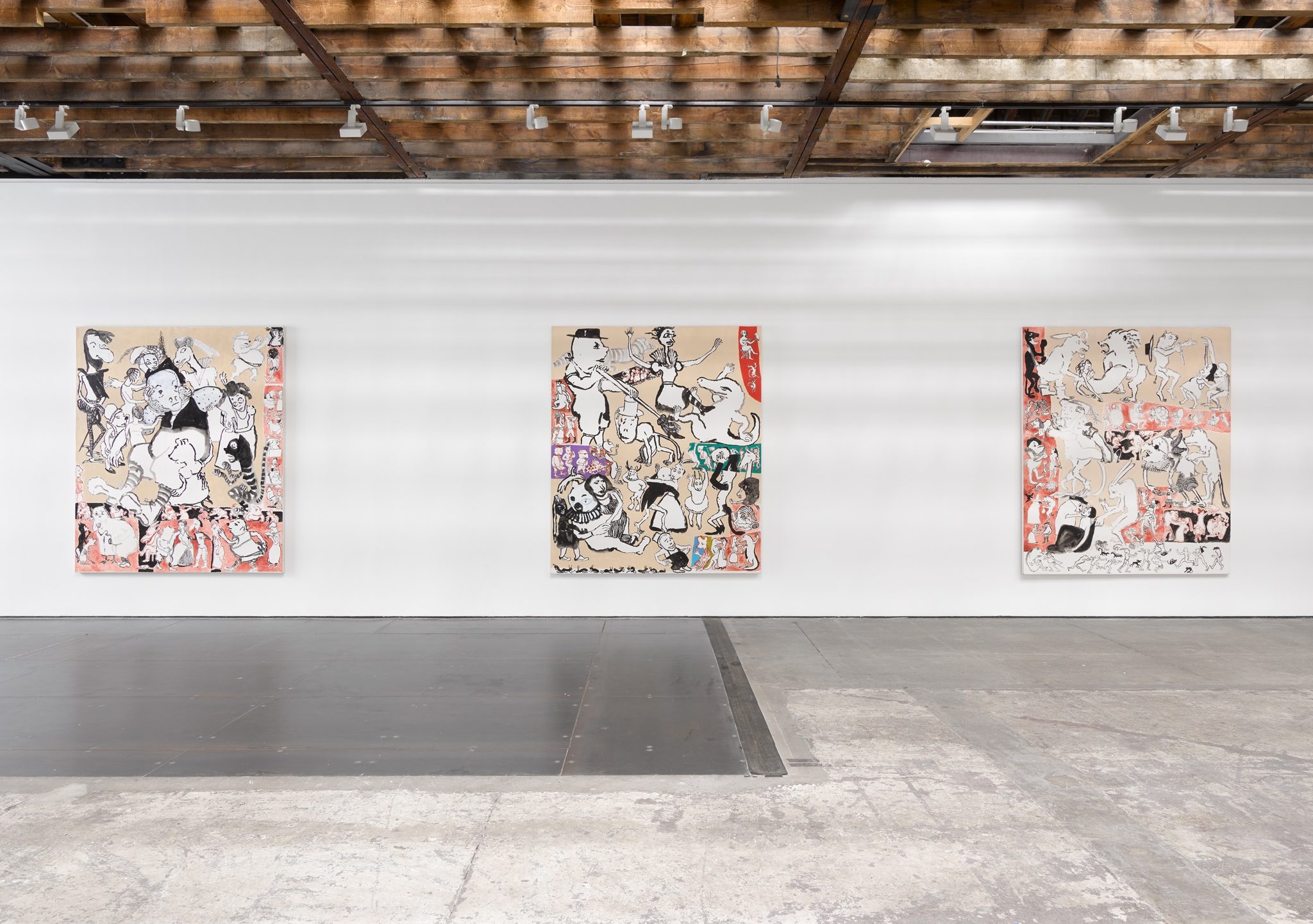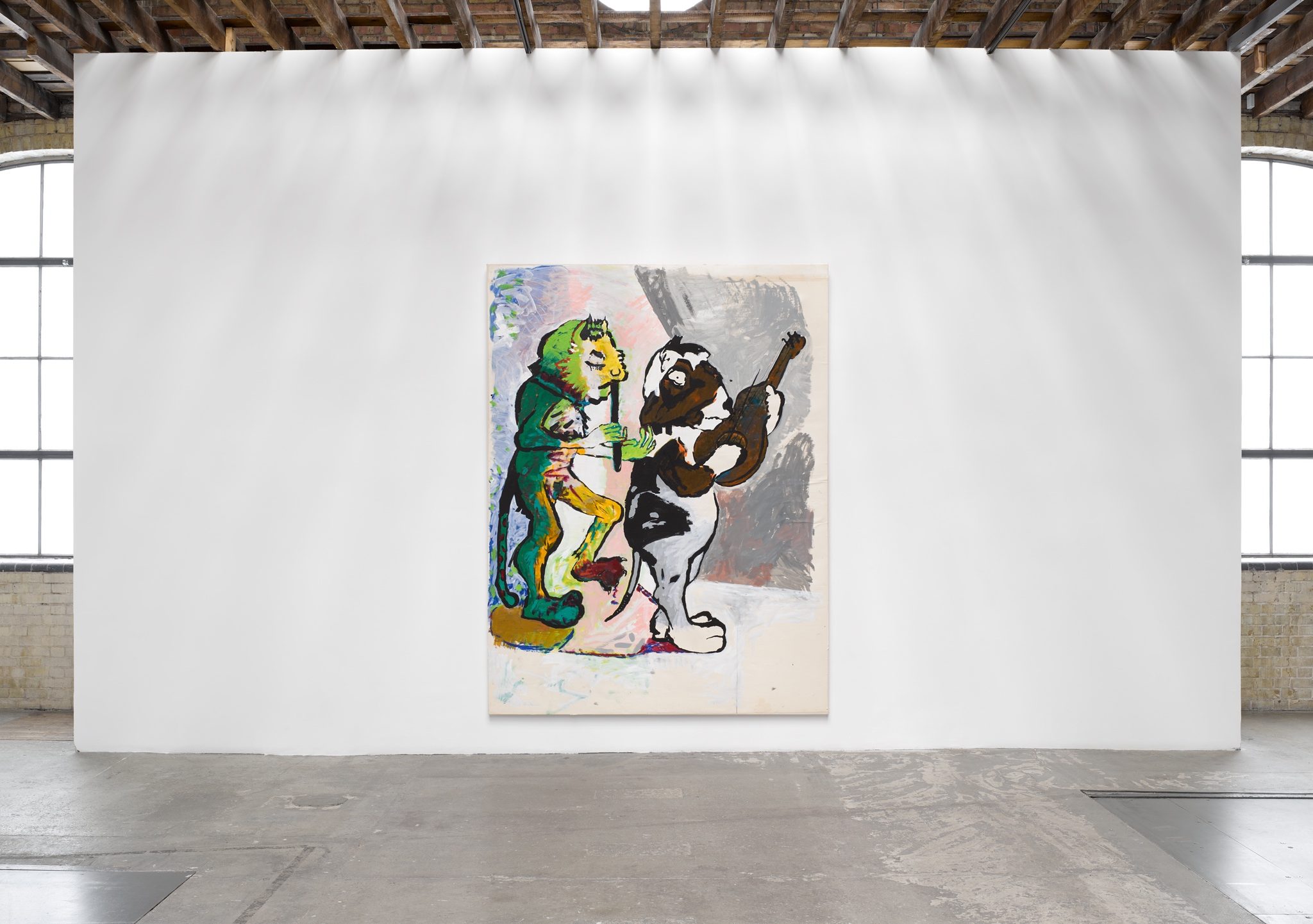Paula Rego: Letting Loose
Exhibition 22 September–11 November 2023
Tuesday–Saturday: 10am–6pm
16 Wharf Road, London N1 7RW
Victoria Miro is delighted to present an exhibition of works by Paula Rego from the 1980s, a period of liberation and self-discovery that led to great breakthroughs for the artist and saw her first major exhibitions in the UK and the US.
‘These paintings, perhaps more than any others, helped her to understand herself and those close to her.’ – Nick Willing
For Paula Rego the 1980s was a decade of creative transformation. Moving away from a process of making collages – drawing and painting material that she would then cut up and arrange into sophisticated figurative puzzles – she began instead to engage with her childhood passion for painting as play. Working rapidly and fluidly, Rego embraced freedom as methodology, inventing a cast of humans, animals and hybrid creatures that, in turn, empowered her to tell her own story.
The exhibition is accompanied by a new publication featuring Becoming Animal, an essay by Cecilia Alemani. Excerpts are featured below along with commentary by the artist’s son, Nick Willing.
Excerpt above: Paula Rego: Secrets & Stories, a unique insight into the life and work of celebrated painter Paula Rego. Directed by her son, filmmaker Nick Willing. © Kismet Films, 2017
Just as collage had enabled Rego to deliver clandestine comments about society (and Portugal’s fascist regime in particular) her new, quickfire method of working, especially its use of anthropomorphism, aided the dramatisation of darker aspects of human nature without mannerism or sentimentality. Rego’s memories and experiences, aspects of loyalty, love, passion, obsession and jealousy, including the shifting dynamics that shaped her own marriage (her husband, the artist Victor Willing, was by the 1980s severely ill with multiple sclerosis) surface in works that helped her to identify her feelings for particular situations; feelings that, once established, might be transformed during the process of painting. As Rego remarked, ‘The reason I make pictures is to find things out.’
These thematic and pictorial shifts in direction gave rise to important bodies of work, including Girl and Dog, the Opera paintings and The Vivian Girls, in addition to paintings inspired by an impactful first visit to New York in 1983.
The series known informally as Girl and Dog is perhaps the most candid exploration of her feelings for Willing – including the complex emotions brought about by caring for him in ill health; representations of faith and devotion that also respond to Rego’s Catholic upbringing. The Outsiders exhibition, held at the Hayward Gallery in 1979, introduced Rego to Henry Darger’s chronicle The Story of the Vivian Girls, an encounter that was to prove as significant as that with the work of Dubuffet in late 1950s. Rego’s Vivian Girls differ from Darger’s in that, exploring her own inner world, they possess far greater agency in their battles, as well as a far greater capacity for revenge.
Completed in 1983, Rego’s Opera paintings tap into an earlier experience of visiting the Lisbon opera house with her father in the 1950s – and her excitement at the intrigue and scandal unfolding both onstage and off. The dramas of Verdi or Janáček mingle with those of Rego’s own life in frieze-like works; works she referred to as ‘the so-called operas’ because they were as much about her relationships as those enacted on stage. Traviata and Falstaff were among paintings included in the exhibition Eight in the Eighties, held in New York in 1983; their enthusiastic reception led to Rego being invited to contribute to a subsequent New York exhibition, titled Marathon 83. Rego’s first visit to the city inspired a number of paintings where her freewheeling figuration finds expression in the dramas and dangers that sit just beneath the surface of sophisticated urban life.
While this success was newfound it was hardly overnight. Rego, by this stage, was almost fifty; highly respected in Portugal since the 1960s, her first solo exhibition in London, held at the AIR Gallery, didn’t take place until the summer of 1981. Yet, the works on view here quickly established her as an important voice in contemporary art, culminating in a solo exhibition at the Serpentine Gallery in 1988. Rego was appointed the first National Gallery Associate Artist in 1989, an accolade that signifies the extent of her rise during this transformational decade.
Untitled
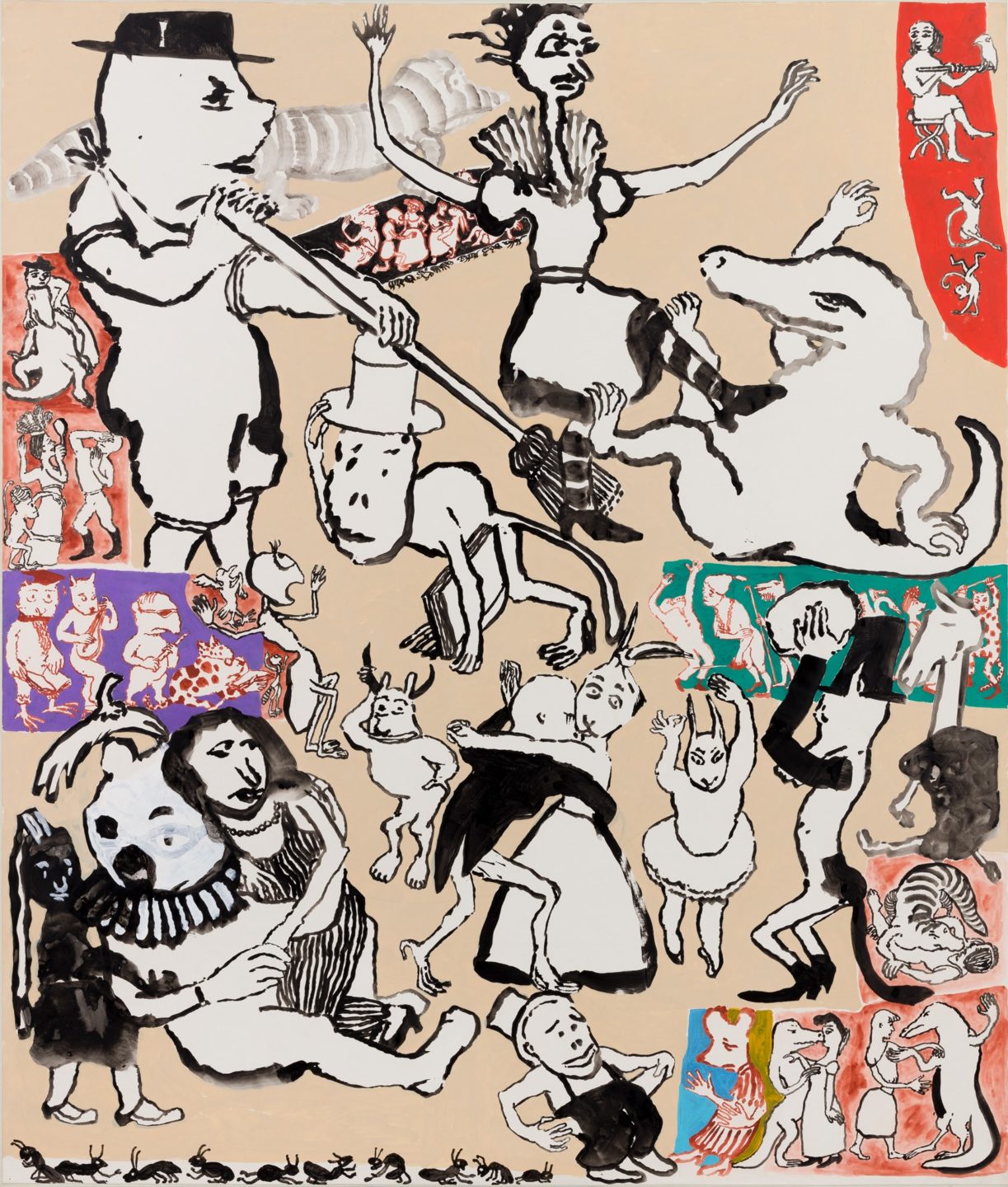
Acrylic on paper on canvas
239 x 202.5 cm
94 1/8 x 79 3/4 in
Paula Rego, Untitled, 1983
More info‘Rego’s paintings swarm with animals and with beings that spring from the intersection of human and non-human, all ensnarled in dangerous liaisons that would once have been called “unnatural”, but which instead merely demonstrate that human beings are deeply rooted in the animal kingdom.’ — Cecilia Alemani
Creatures
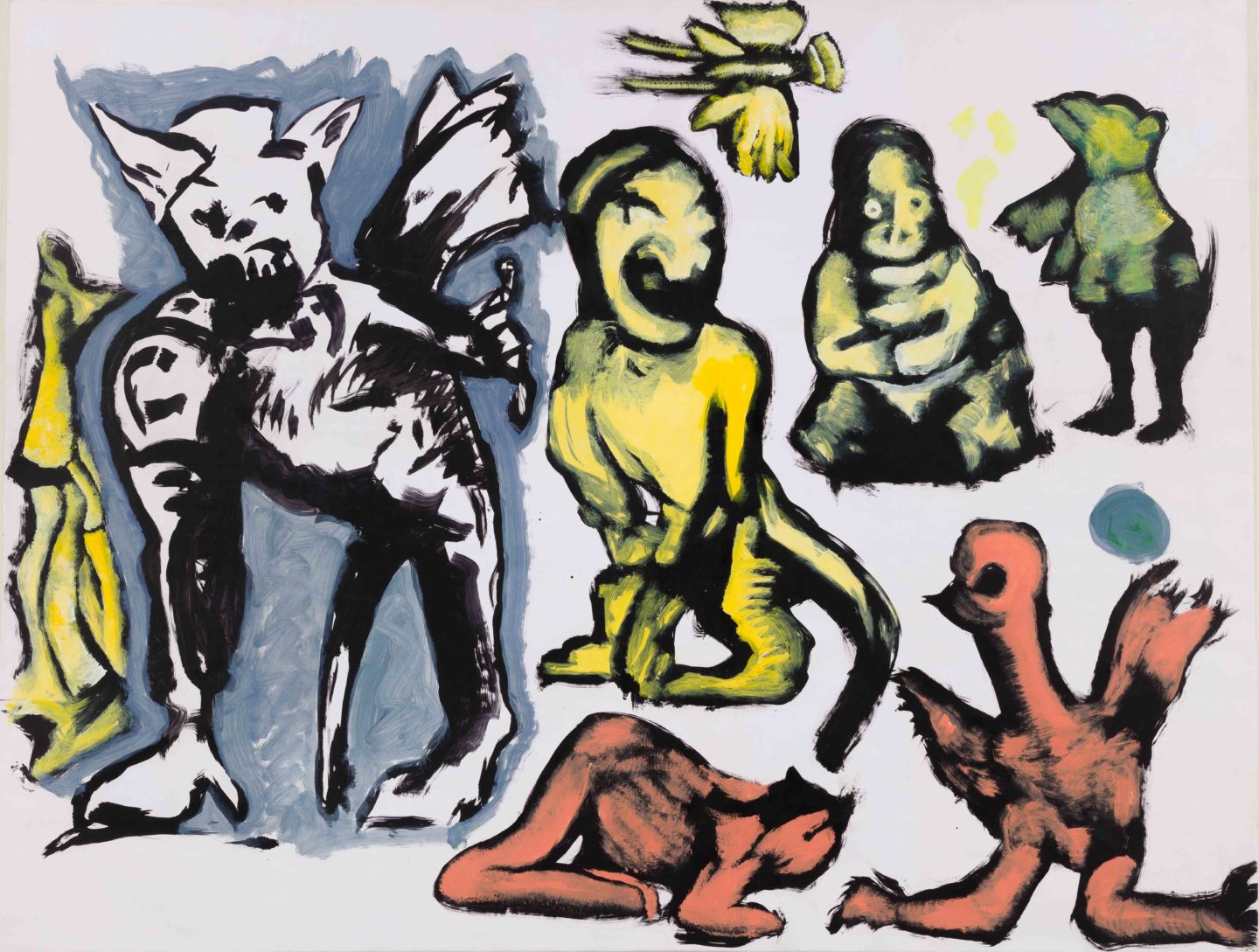
Acrylic on paper on canvas
150 x 200 cm
59 x 78 3/4 in
Paula Rego, Creatures, 1981
More info‘The 1980s drew in an era of “anything goes”, of excess and liberation, of letting loose. This new-found freedom set off an explosion in the studio… Animals appeared, scheming, smoking, cheating, fighting, crowding large canvases, acting out her fantasies with humour and malice.’ — Nick Willing
Aida/Jenufa
‘As a teenager Paula would often accompany her father to the Lisbon opera house, but the evening was not just about what was on the stage, it also offered a glimpse into the city’s high society. It was the intrigue, scandal, gossip, on and off the stage that made her mind buzz.’ — Nick Willing
Musicians
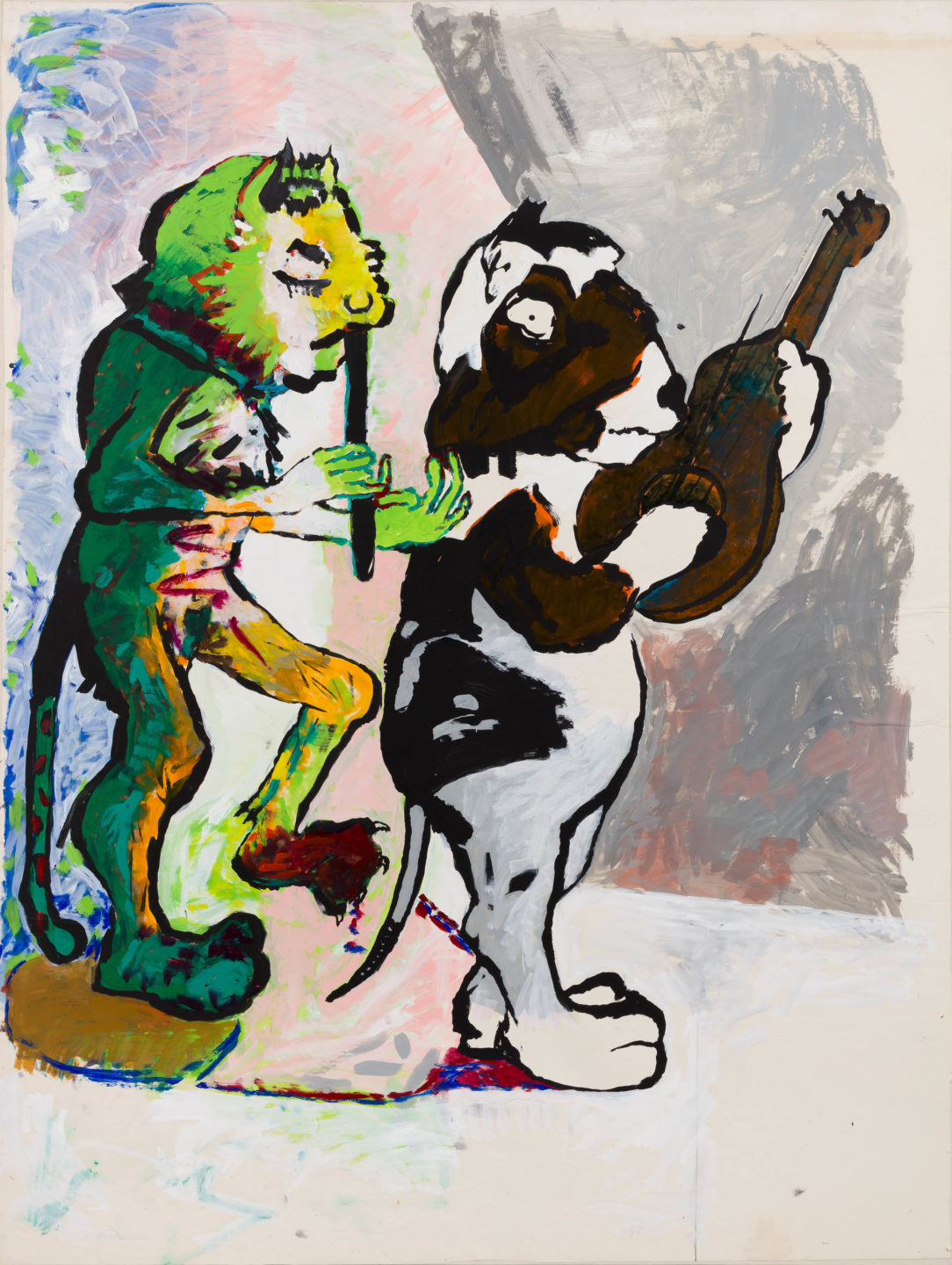
Acrylic on paper on canvas
272 x 204.5 cm
107 1/8 x 80 1/2 in
Paula Rego, The Musicians – Cat and Guinea Pig, 1981
More infoFalstaff/La Traviata
‘The highs and lows of her own life were mixed up with the famous stories, enhancing and polluting their drama. These aren’t illustrations, they’re emotional hieroglyphs that tell a more personal story.’ — Nick Willing
Vivian Girls
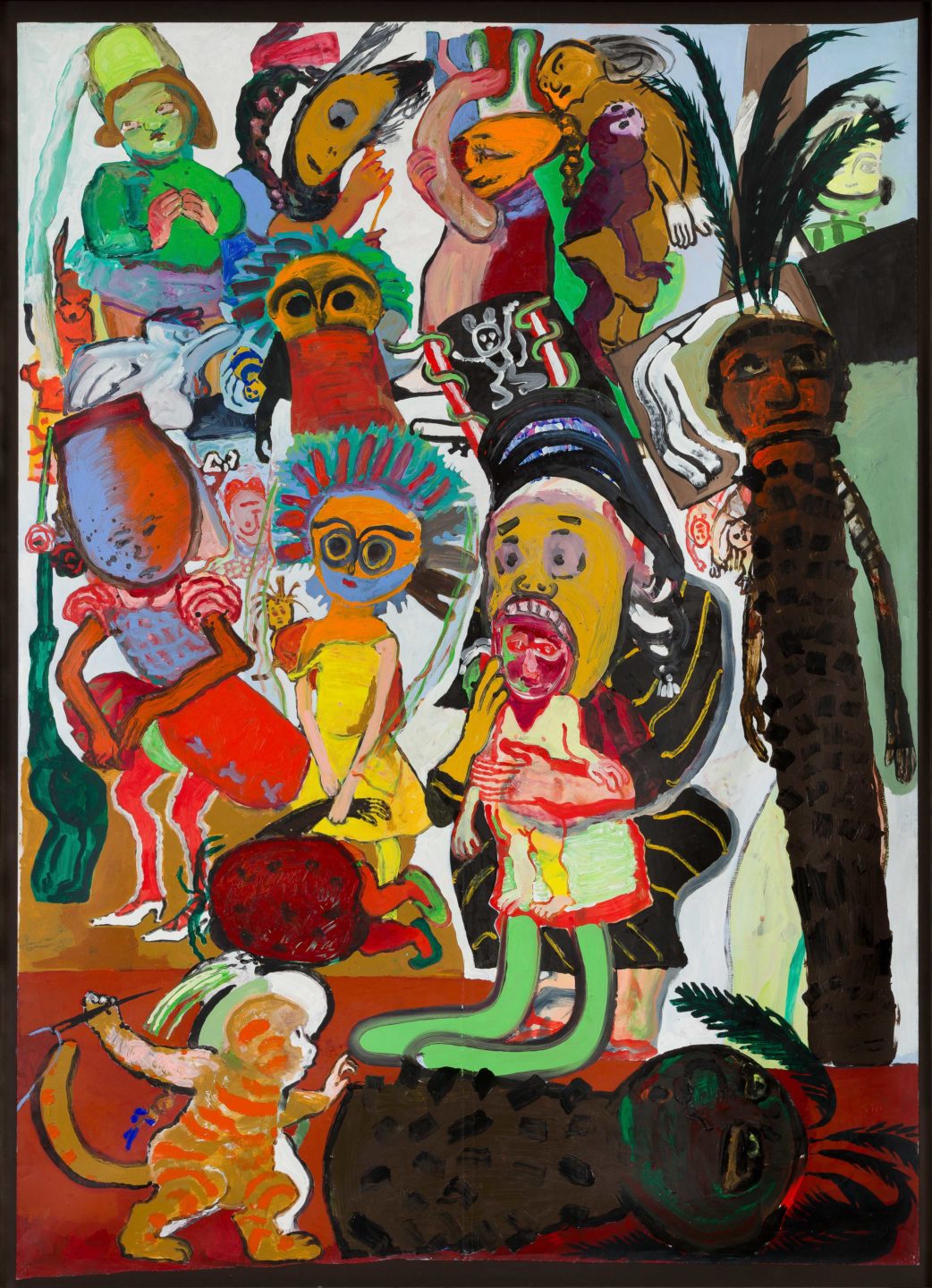
Acrylic on canvas
249.8 x 181.1 cm
98 3/8 x 71 1/4 in
Paula Rego, The Vivian Girls in Tunisia, 1984
More info‘Among the creatures that haunt these paintings, it is also surprising to discover Henry Darger’s Vivian Girls. The fact that Rego was familiar with Darger’s work as early as the 1980s shows her insatiable curiosity and her taste for a nocturnal, anti-academic kind of art.’ — Cecilia Alemani
Central Park
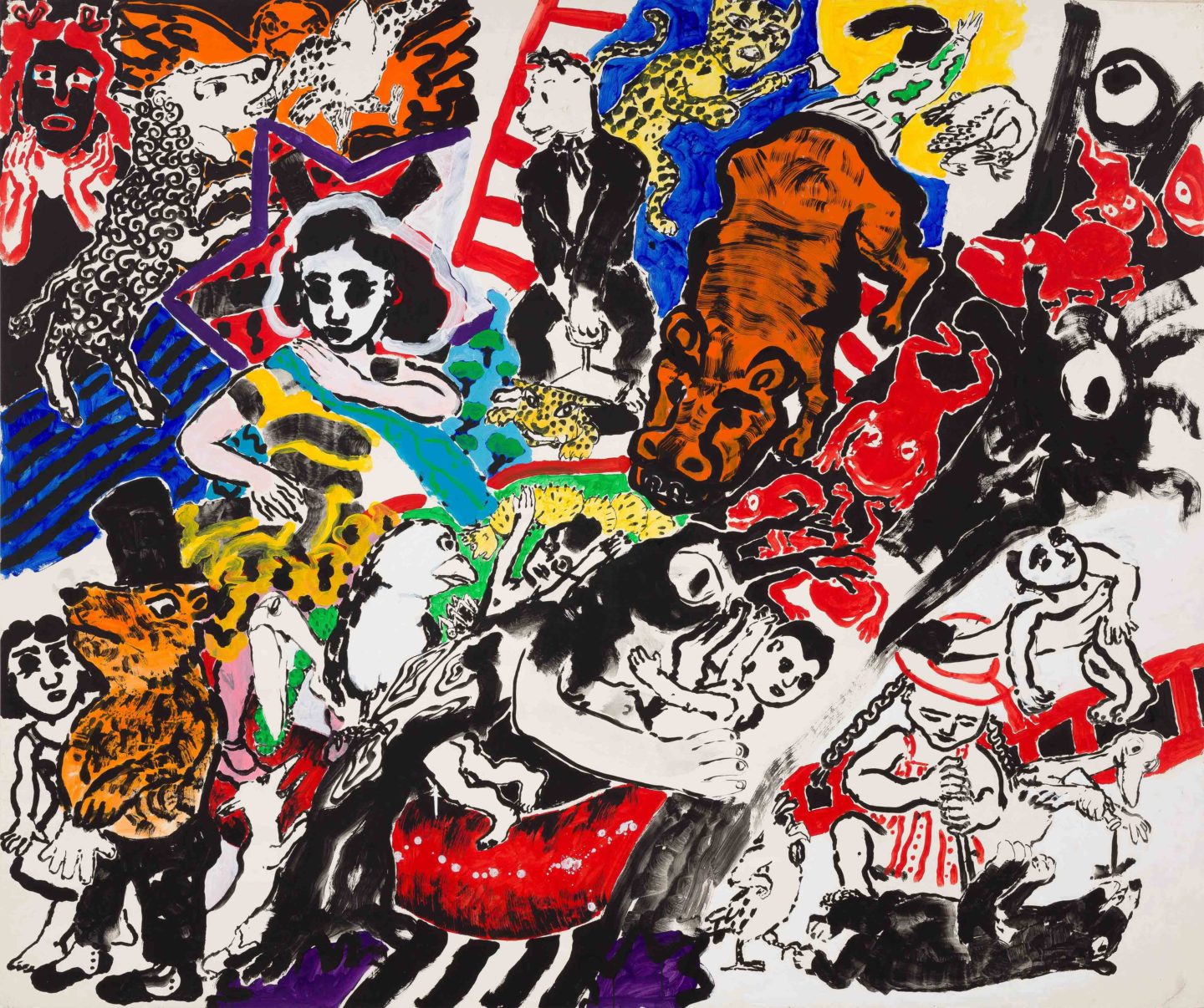
Acrylic on paper on canvas
218 x 259 cm
85 7/8 x 102 in
Paula Rego, Central Park, 1984
More info‘It was the first time Paula had visited New York and it undoubtedly left its mark. She loved the contradictions she found there.’ — Nick Willing
Corrida(Race)/Marathon Running
‘She used her opera’s hieroglyphic style to reflect the drama of the marathon in Corrida before trying something more flamboyant in Marathon. There’s a sense of hysteria, of fight or flight about these runners. Are they racing or running for their lives?’ — Nick Willing
In and Out of the Sea
‘By the time we get to In and Out of The Sea, the high octane fireworks that Paula ignited in 1981 have a more epic quality. The brown bear sails on an odyssey full of challenges and pleasures.’ — Nick Willing
Publication
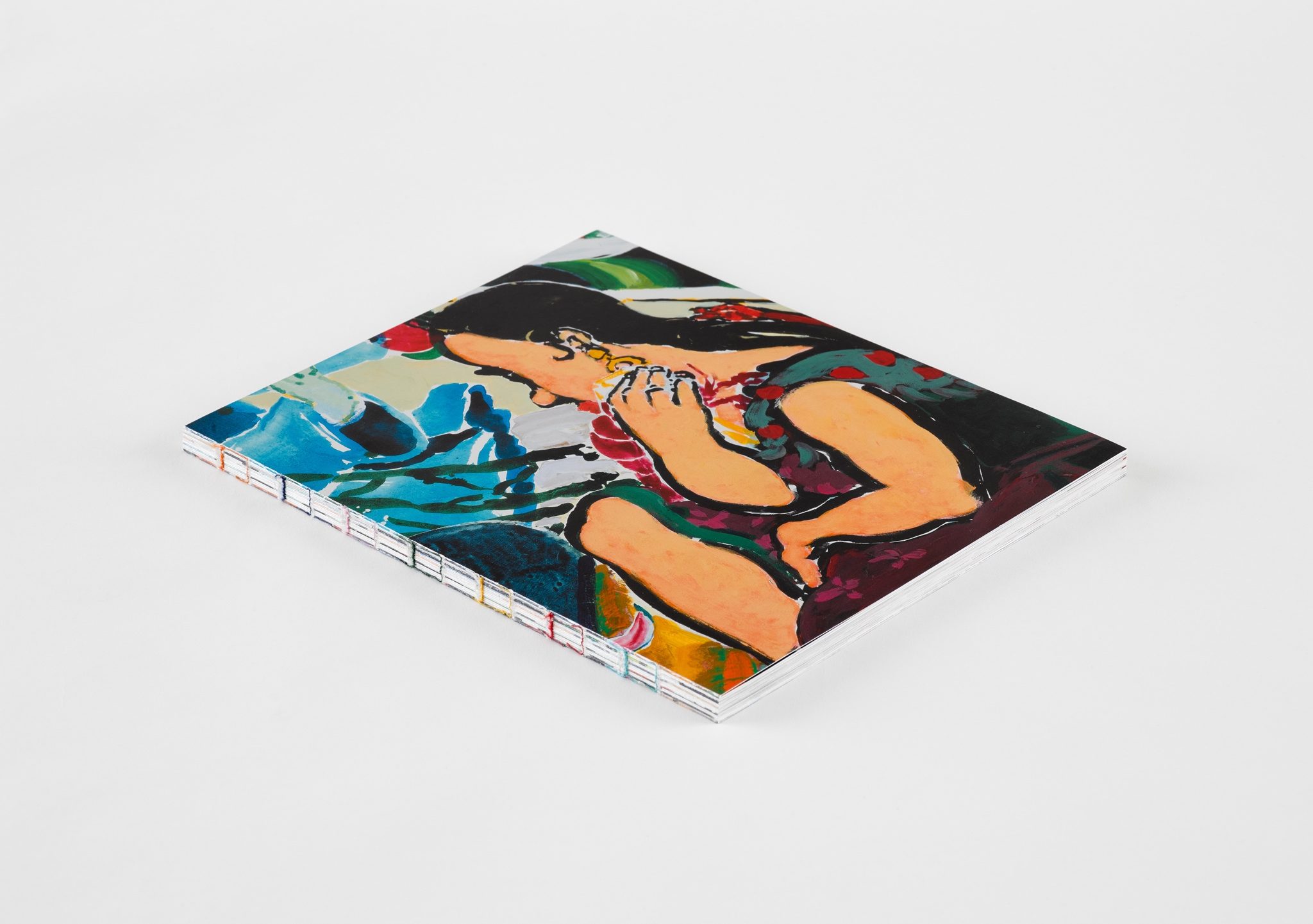
Produced on the occasion of the exhibition, this new publication features an essay by Cecilia Alemani:
‘The customary switching of roles that bestows human traits on animals – a trope of fairy tales and parodies that begins with Homer’s Battle of the Frogs and Mice and Aesop’s fables, if not earlier, and stretches all the way to George Orwell and Walt Disney – arrives at a deeper and more harrowing transformation in Rego’s paintings. What emerges from these jumbles of bodies, in which women, dogs, rabbits, monkeys, and crocodiles are all intertwined, is a world where humanity behaves in animalistic ways.’
The 108-page exposed-bound book is richly illustrated with 23 colour plates.
It is designed by Joe Hales and printed by Roy Killen.
Special exhibition price £35.
About the artist
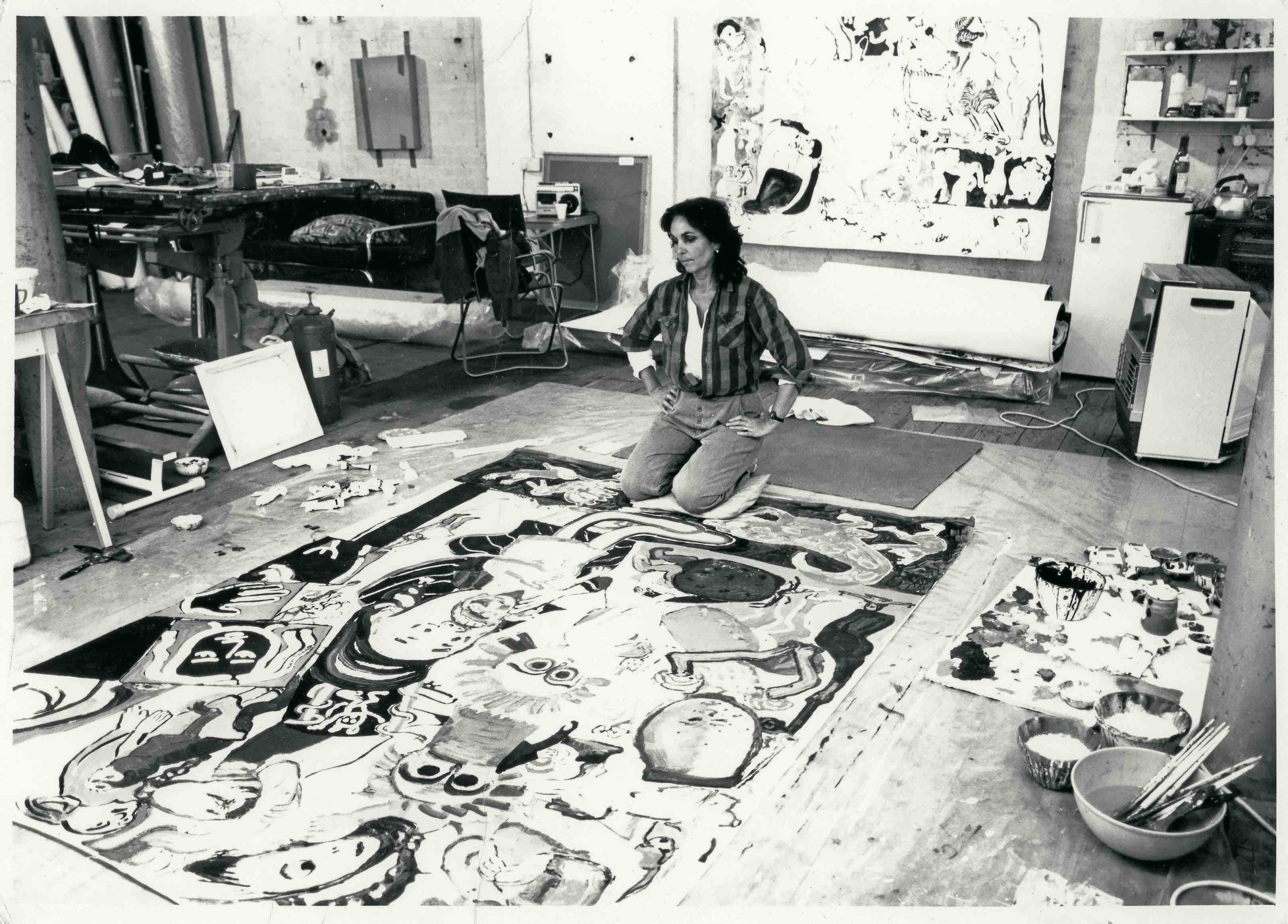
Dame Paula Rego RA was born in 1935 in Lisbon, Portugal. She died in London on 8 June 2022. The largest and most comprehensive retrospective of Rego’s work to date was held at Tate Britain in 2021 (7 July–24 October 2021) and travelled to Kunstmuseum Den Haag, The Netherlands (27 November 2021–20 March 2022), and Museo Picasso Málaga, Spain (26 April–21 August 2022). Works by the artist featured in the 59th International Art Exhibition of La Biennale di Venezia, The Milk of Dreams, curated by Cecilia Alemani (23 April–27 November 2022).
A presentation of Crivelli’s Garden, Rego’s monumental work commissioned as the first National Gallery Associate Artist and completed in 1991, is on view at the National Gallery, London, from 20 July–29 October 2023.
Other recent major solo exhibitions include Paula Rego: The Story of Stories, Pera Museum, Istanbul, Turkey (2022–2023); Paula Rego: There and Back Again, Kestnergesellschaft, Hannover, Germany (2022–2023); Paula Rego: Subversive Stories, featuring prints from across her career, at Arnolfini, Bristol, UK (2022); Paula Rego: Literary Inspirations at Petersfield Museum, Hampshire, UK (2022); Power Games, Museum De Reede, Antwerp, Belgium (2021), and Paula Rego: Obedience and Defiance, curated by Catherine Lampert, which travelled from MK Gallery, Milton Keynes to the Scottish National Gallery of Modern Art, Edinburgh in 2019–2020 and was on view at the Irish Museum of Modern Art, Dublin from September 2020–May 2021.
Earlier solo exhibitions include: Paula Rego – The Scream of Imagination | In Keys, organised by the Serralves Foundation, on view at MACNA – Museu de Arte Contemporânea Nadir Afonso, Chaves, Portugal (2020); Giving Fear a Face, CEART: Centro de Arte Tomás y Valiente, Madrid, Spain (2019); The Cruel Stories of Paula Rego, Musée de l’Orangerie, Paris, France (2018–2019) and Folktales and Fairy Tales, Casa das Histórias Paula Rego, Cascais, Portugal (2018). Exhibitions of her work have been held previously at venues including: Museo de Arte Contemporáneo, Gas Natural Fenosa, La Coruña, Spain (2014); the Museum of Contemporary Art, Monterrey, Mexico; Pinacoteca de São Paulo, Brazil (2010-2011); École supérieure des beaux-arts, Nîmes, France (2008); Museo Nacional Centro de Arte Reina Sofía, Madrid, Spain; National Museum of Women in the Arts, Washington D.C., USA (2007–2008); Fundação das Descobertas, Centro Cultural de Belém, Lisbon, Portugal (1997); Tate Liverpool, UK (1996–1997); AIR Gallery, London, UK (1981). Recent international group exhibitions include All Too Human: Bacon Freud and a Century of Painting, Tate Britain, London, UK (2018); travelled to Museum of Fine Arts, Budapest, Hungary; Post-Pop, Outside the Commonplace, Gulbenkian Museum, Lisbon, Portugal (2018); Macau Biennial, Macau Museum of Art, Macau, China (2018); Bacon, Freud and the School of London, Museo Picasso, Malaga, Spain; travelled to ARoS, Aarhus, Denmark (2017–2018). Her work is in the collections of numerous museums including the British Museum, Tate, National Gallery and National Portrait Gallery, London, UK; The Metropolitan Museum of Art, MoMA, The Morgan Library & Museum, New York, USA; The Art Institute of Chicago, USA and the Yale Center for British Art, New Haven, USA.
In 2010, Rego was made a Dame of the British Empire for services to the Arts in the Queen’s Birthday Honours and was awarded the prestigious Grã-Cruz da Ordem de Sant’Iago da Espada from the President of Portugal in 2004. Rego has received several Honorary Doctorates from universities including the University of St. Andrews (1999), University of East Anglia (1999), Rhode Island School of Design (2000), The London Institute (2002), Oxford University (2005), Roehampton University (2005), Faculdade de Belas-Artes at the University of Lisbon (2011), and the University of Cambridge (2015).
Rego was the recipient of many awards such as the Honors Medal of the city of Lisbon, Portugal (2016), the Maria Isabel Barreno prize (2017), Portuguese Government’s Medal of Cultural Merit (2019) and the Lifetime Achievement Award from Harper’s Bazaar (2019).
